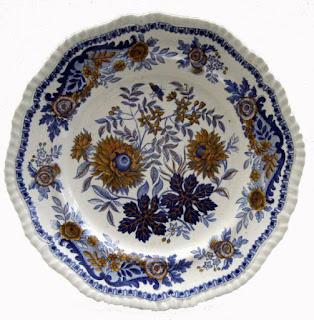 |
| Soup plate, handpainted, pattern B1 c1823 |
About 75,000 patterns are recorded in the Spode pattern books. As the Spode company grew and more and more patterns were recorded, different series of patterns were given different prefixes. The first series has no prefix. Many series run from 1-9999 which means that most have many books in them.*
Some series are shorter and only have a few volumes. The B series has just one. The patterns in the B Book are given a number prefixed with B running from B1 to B959. As usual, dating Spode patterns exactly is difficult but the B Book is thought to date from c1823 to c1848. **
 |
| Plate, pattern B107, printed & hand coloured c1825 |
So, what exactly are the B patterns?
The significance of patterns prefixed with a B is that the pattern, whether printed, handpainted or a combination of both, was decorated completely underglaze.
The type of patterns in the B Book is difficult to sum up as at first glance they seem such an odd mixture. The original purpose of their differentiation was simply to show they were decorated all underglaze so no mistakes were made in manufacture.
 |
| Plate, pattern B68, handpainted in blues and yellow c1824 |
 |
| Plate, Gadroon shape, pattern B111, 'Trophies-Marble' c1826 |
B111 is a version of 'Trophies-Marble' pattern. It was printed in blue and hand coloured all underglaze. Its unique number would prevent any mix up in the customer orders which could occur if only a pattern name was used. It is quite possible for many, many versions of a pattern to be produced in different colourways. Other transfer printed patterns e.g. 'Italian' were also produced with added colour but in its most familiar version, pattern 2614, 'Italian' is printed underglaze and then painted and gilded onglaze.
 |
| Plate, Gadroon shape, pattern B118 'Jasmine' c1826 |
 |
| Plate, 'Blue Rose' border, pattern B176 c1826 |
 |
| Plate, 'Cotton Sprigs', pattern B362 c1832 |
 |
| Dessert plate, pattern B364 c1832 |
 |
| Dessert dish, pattern B364 c1832 |
 |
| Garden seat, pattern B516, Copeland & Garrett c1838 |
 |
| Bidet in stand, pattern B516, Copeland & Garrett c1838 |
 |
| Cover to bidet cabinet |
 |
| Plate, pattern B773 c1844 |
The pattern book page for B773 can be found here>.
I think it is an interesting book for researchers and collectors as there are so many surprising patterns in it. Just when you think you know the style of designs that Spode produced in the early 1800s the B Book makes you think again...
________
*For more details on how the pattern books developed and their dates see Robert Copeland's marvellous book: 'Spode & Copeland Marks & Other Relevant Intelligence',
Studio Vista, 2nd edition 1997 ISBN 0 289 80069 2
The relevant pages are 117-124 from where the image of B68 is also taken.
Since publication, new information has come to light about the discovery of another pattern book in 1988 (in a private collection; p117-118) originally thought to be Spode but which is now thought not to be Spode.
**There are some pages in the B Book with patterns prefixed with C. Some sheets seem to have been bound in by mistake; and others seem to have had the the C prefix by mistake or... are actually C patterns in the wrong book. The C Book is a pattern book recording handpainted designs which are described by Robert Copeland as 'cheap and cheerful' and date from 1845-1870.
*** A full comparison between the B Book and the small B Book was done by the late Bill Coles working as a volunteer for me in 2003. The comparisons are interesting and sometimes the small book gives more details than the main book.
The relevant pages are 117-124 from where the image of B68 is also taken.
Since publication, new information has come to light about the discovery of another pattern book in 1988 (in a private collection; p117-118) originally thought to be Spode but which is now thought not to be Spode.
**There are some pages in the B Book with patterns prefixed with C. Some sheets seem to have been bound in by mistake; and others seem to have had the the C prefix by mistake or... are actually C patterns in the wrong book. The C Book is a pattern book recording handpainted designs which are described by Robert Copeland as 'cheap and cheerful' and date from 1845-1870.
*** A full comparison between the B Book and the small B Book was done by the late Bill Coles working as a volunteer for me in 2003. The comparisons are interesting and sometimes the small book gives more details than the main book.

